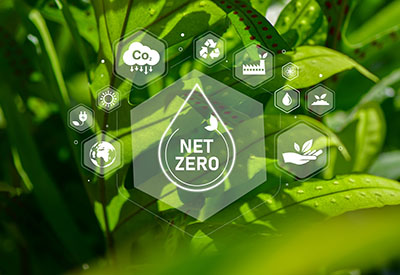Net Zero Meaning
“Net-zero emissions” might seem like a buzzword, but it’s an important goal for mitigating the impacts of climate change. Achieving net zero means reducing greenhouse gas (GHG) emissions as much as possible. While shifts to wind, power, and solar energy are critical, some processes will still require the use of greenhouse gases – that’s why the goal is net zero, and not the complete elimination of emissions. With practices in place to support carbon sequestration, governments and businesses can “break even” on their emissions levels.
Is There A Global Effort to Reach Net Zero?
Yes: the Paris Agreement seeks to reach net-zero emissions by 2050, with the interim goal of reducing emissions by 45% by 2030. A legally binding international treaty on climate change, the Paris Agreement has over 190 signatories, including major industrialized nations like the United States, China, Russia, India, Japan, and Germany. Many of these countries, as well as private companies, colleges and universities, and financial institutions, have set net-zero targets.

Net-zero Strategy and Science-based Targets for Companies
Global targets for emissions and climate-smart practices are generally dictated by international agreements, including the Kyoto Protocol and the Paris Accords. While these agreements are signed by government leaders, the private sector has an important role to play in achieving net-zero emissions. McKinsey & Company suggests several areas of focus for the private sector:
- Long-term planning: Businesses will need to develop comprehensive plans to achieve net-zero emissions, which may include developing new products, retrofitting existing processes, or entering new markets.
- Internal operations: Climate factors should be key considerations in a company’s risk management strategy and their day-to-day operations. They may also need to upskill their existing workforce or hire new talent to support shifts toward greener technologies and processes.
- Data and analytics: Companies will need tools to track their emissions, stay abreast of changing regulations, and create transparency across their operations.
Why Is Getting to Net-zero Emissions Important?
Achieving net-zero emissions is no longer a lofty goal of climate advocates – it’s now an economic and moral imperative. GHG emissions from human activities are taking a toll on people, animals, and the planet. The Environmental Protection Agency (EPA) reports that global temperatures have risen 0.17°F on average in the last 100 years – and the United States has warmed faster than the global average. These warmer temperatures lead to heat waves, floods, rising sea levels, and severe weather patterns.

The Role of SF6 Gas In Net-zero Efforts
The Transmission and Distribution of Energy Industry is responsible for about 80% of SF6 gas emissions. Businesses and utility companies that work with SF6 gas have a major opportunity to advance net-zero goals, especially because SF6 has a lifespan of 3,200 years – making it significantly more harmful than CO2. SF6 emissions are typically caused by improper handling, equipment failure, or leaks. Gas-insulated equipment (GIE) has a lifespan of more than 30 years, so companies that use GIE must conduct regular equipment inspections and maintenance to prevent leaks.
At DILO, we take a multi-pronged approach to achieving our zero emissions philosophy. It includes:
- Reconditioning: We provide reconditioned SF6 gas that meets or exceeds IEEE standards.
- Equipment: DILO manufactures zero-emission industrial gas equipment and offers custom plant engineering for gas applications. DILO also has a complete line of gas handling devices for Alternative Gases.
- Training: Properly trained technicians are a vital component to preventing SF6 emissions. DILO offers virtual and in-person SF6 safety and handling training classes for our customers through DILO Academy.
What the Future Holds for Net-zero Emission Targets
World Resources Institute reports that countries are not on track to limit 2.7 °F (1.5 °C) despite progress towards net zero emissions. Efforts to phase out coal, slow deforestation, and replace gas-burning vehicles with electric cars must rapidly scale up in the next few years. Businesses can support net-zero goals in the electric industry by adopting alternative gases in addition to implementing best practices for SF6 gas handling.

Expertise in Emission-Free Gas Handling
Electric companies, cooperatives, universities, and research organizations that use SF6 will find a trusted partner in DILO. Committed to using the highest standards of quality and safety, DILO is a leading expert in SF6 gas handling and reconditioning. DILO manufactures equipment for SF6 gas handling as well as alternative gases like C4-FN and C5-FK Dielectric Fluids. Don’t take chances when it comes to SF6 gas and other insulating gases – count on the experts to help you reduce your GHG emissions. Contact us today!





